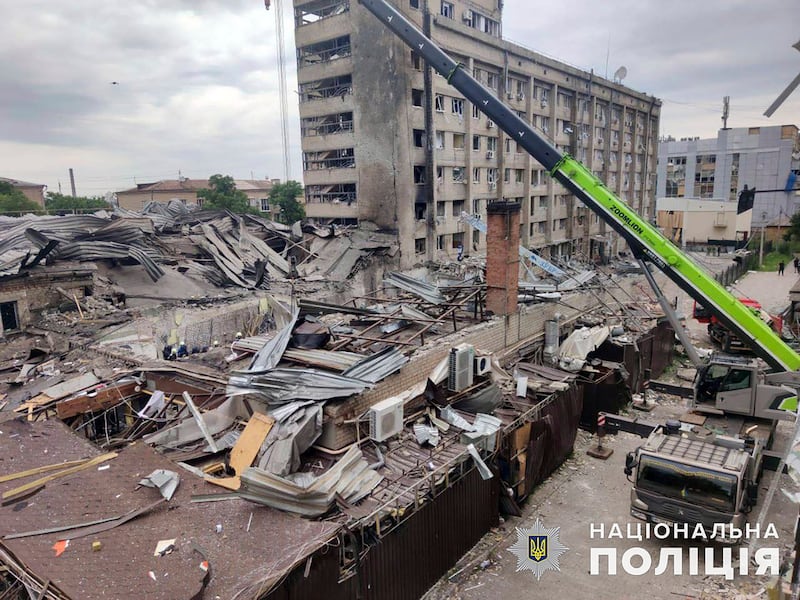Four foreign correspondents covering the Spanish civil war were sitting down for dinner together on a Monday night in Bilbao after a difficult day’s reporting when the news reached the city that the nearby town of Guernica had been bombed from the air.
In April 1937, bombing places where people live, beyond the front lines, was a new innovation of warfare. It was of intense public interest, as there was alarm about the use of this technique by the newly rearmed German air force, dispatched to help Gen Francisco Franco wrest power from the democratic government of Spain.
The four journalists – Mathieu Corman of French daily Ce Soir, Noel Monks of the Daily Express, Reuters’ Christopher Holme and The Times’s George Steer – left their table and drove together to reach the burning market town, where they witnessed desperate attempts to pull survivors from the rubble and interviewed survivors.
It was Holme’s report that was printed in The Irish Times for the public to read on Wednesday morning: “Guernica, the ancient capital of the Basque country, has been reduced to ruins following an air raid.”
[ Eta is dead so why do Spanish politicians never stop talking about it?Opens in new window ]
[ Exhumation of civil war victims begins from Spain’s biggest mass graveOpens in new window ]
“It is not yet known how many hundred civilians – men, women and children – lost their lives from shells or flames during the 3½ hours’ bombardment. Many of those who had raced desperately for the open fields were systematically pursued and machine-gunned from the air by swooping fighters,” Holme wrote.
“They showed me a bomb shelter in which over 50 women and children were trapped and roasted alive. Everywhere is a chaos of charred beams, twisted girders, broken masonry and smouldering ashes, with forlorn groups of inhabitants wandering in search of missing relatives.”
A furious response on the letters page the following day took aim at the part of Irish society that was sympathetic to Franco on Christian grounds, due to the anticlerical violence seen in parts of anti-Fascist Spain.
“What right have these Basques to fight for their independence and freedom, or to wish to set up a Republic of their own?” GW Keegan of Miltown Road wrote with bitter sarcasm. “This is a question which every Irishman should ask himself, and, if he be a true Irishman, he will undoubtedly give himself the right answer.”
Images of the skeletal remains of the historic heart of Basque identity were printed around the world and shifted public opinion, making Guernica an international symbol of an inexcusable civilian atrocity.
In exile in Paris, the most famous painter in the world saw the reports in his favourite newspaper, l’Humanité. Pablo Picasso chose Guernica as the subject of a mural he was commissioned to paint by the embattled Spanish government, for display at their pavilion at the Paris World Fair.
It was unveiled there two months later, physically wedged between the grandiose twin displays of Germany and the Soviet Union, the emerging authoritarian powers that were testing each other in Spain.
[ Ukraine attacking near Bakhmut and Kherson as Kyiv warns of nuclear plant threatOpens in new window ]
Picasso did not live to see the fulfilment of his wish that the painting should go to Spain once democracy was restored. It finally returned after the end of Franco’s dictatorship, in 1981.
I stood in front of Guernica in Madrid this week among a group of foreign correspondents invited by the Spanish government to mark its assumption of the six-month EU presidency.
In the way of great art, Guernica has elements that seem prophetic or universal, beyond what the artist could have foreseen.

How could Picasso have known how perfectly the bird, blasted up in terror, tells of the environmental catastrophe of Russia’s invasion of Ukraine?
How could he have known that the horrified figure peering into the carnage of the bombed interior echoes the videos by volunteers who snuck into Bakhmut to extract people from basements as the town was pummelled to dust?
[ Kramatorsk explosion: How a night out for dinner ended in destruction and deathOpens in new window ]
How could he have known that the painting’s chaotic geometry in grisaille – a technique of using grey tones used in Spanish art to depict the horrors of war since Francisco de Goya – would seem to precisely describe the aerial images of the bombed-out Ria Pizza restaurant of Kramatorsk?
It was impossible not to view the painting in the light of that bombing, as just before our visit, the news broke that the flower of Ukrainian literature, Victoria Amelina, had not survived her injuries from the attack.
In its time, the bombing of Guernica was understood as an attempt to crush the Basques through force of cruelty, taking aim at what they treasured most. Nearly a century on, it has not dated as a rebuke of a grotesque European invention of war.















